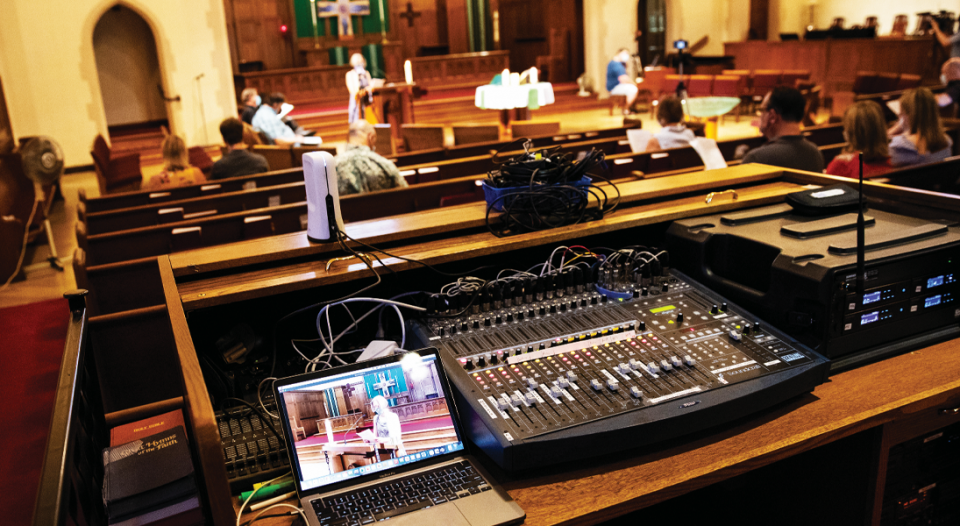The church’s digital reformation began the morning of Friday, March 13, 2020. Following the declaration of the pandemic as a national emergency, congregations across the country swiftly moved their worship services online. In just three days, faith leaders developed a new model of church community, experienced through livestreams, social media and video conferencing.
As the pandemic continues, congregations have experienced tension between those who prefer a return to in-person worship and those who wish to continue online. Without a definitive date when all members might feel ready to return, congregation leaders have developed another model. This is the practice of hybrid ministry—a way of being church that blends the offline with the online.
The defining attribute of hybrid ministry is parity of experience. To be a hybrid ministry is to be a congregation that integrates the physical and the virtual with few discernible differences. When congregations plan for and develop their own hybrid ministry, they’re committing to building bridges between the physical and the digital so that worshipers have the same access and experience regardless of their location.
In this sense, hybrid ministry is distinctive from “digital ministry.” The objective of a hybrid church is not to create a separate, digital version of a congregation, with prerecorded worship services and stand-alone digital content. Rather, the goal is to integrate the online with the offline, to combine the wide-reaching connections of cyberspace with the strong communal bonds of the local congregation.
Inclusivity and hospitality
The practice of hybrid ministry depends more on a congregation’s resourcefulness than its resources. Low-tech congregations with limited budgets can be as effective at this model of Christian community as those with professional media teams because the key is a consistent commitment to inclusivity and hospitality.
A hybrid worship service begins with inclusive, hospitable language that welcomes the online and in-person worshiper. The low-tech requirement of this is the easiest aspect of hybrid worship, yet it’s also the most critical. Without inclusive language, the online worshiper will feel like a second-tier attendee with a back-row seat.
Every component of the liturgy provides an opportunity to extend hospitality to the virtual worshiper. Everything from the greeting to the sermon, the prayers to the announcements could include a word of affirmation for those in both physical and virtual spaces.
An inclusive greeting might remind everyone gathered that they are the church, wherever they find themselves for the service. Inclusive and hospitable announcements might include directions for connecting physically and virtually (Zoom links, URLs, etc.) to each aspect of the congregation’s life together. Inclusive preaching and prayers might give voice to the concerns of those gathered online, inviting virtual attendees to contribute prayer petitions.
Worship planners don’t need to mention “digital” or “hybrid” in each piece of the liturgy, but they should provide a consistent thread of hospitable language. Each week the worship planner should highlight where these threads will be most visible.
Simple involvement might resemble a prayer request submitted via text or social messaging, or an invitation to respond to the sermon via Facebook or YouTube comments.
Beyond inclusive language, hybrid ministry necessitates the liturgical involvement and leadership of those gathered virtually. If those who worship online are offered only the opportunity to passively watch a livestream, they can’t contribute to the work of the people. Failing to involve online attendees also creates a second-tier virtual worship experience. Those gathered face-to-face join for liturgy, or the work of the people. Those gathered online sit and watch.
When planning leadership for virtual worship, start with small acts of involvement before designing more complex roles. Simple involvement might resemble a prayer request submitted via text or social messaging, or an invitation to respond to the sermon via Facebook or YouTube comments. Once the worship planner has established a pattern of virtual involvement, they can create opportunities for online leadership roles: lectors, cantors, presiding ministers and even preachers.
Not every service needs a lector who records their reading offsite, perhaps at a location that complements the reading. Not every Sunday needs the prayers of the people read via Zoom. Still, creating opportunities for involvement turns worship into a truly hybrid experience.
Conversations about hybrid ministry tend to focus on hardware and software. It’s certainly important to attend to streaming platforms, microphone setups and camera positioning, but none of these will create community across digital and physical spaces. Hybrid ministry depends far more on inclusivity than on information technology. At this stage of the pandemic, many church leaders are worried about sustaining their digital efforts. Focusing on inclusivity might make this work more feasible and, ultimately, more durable.






